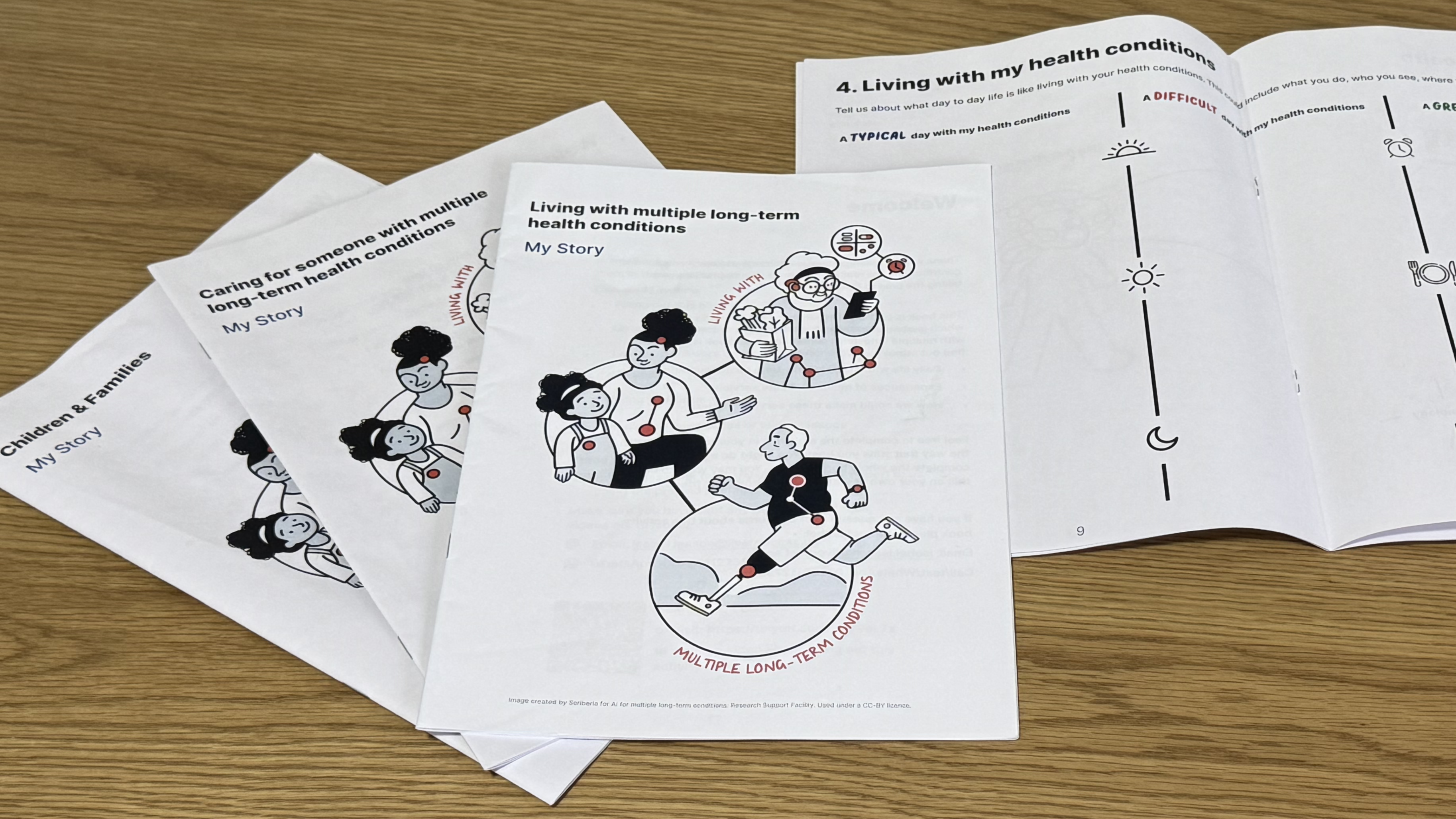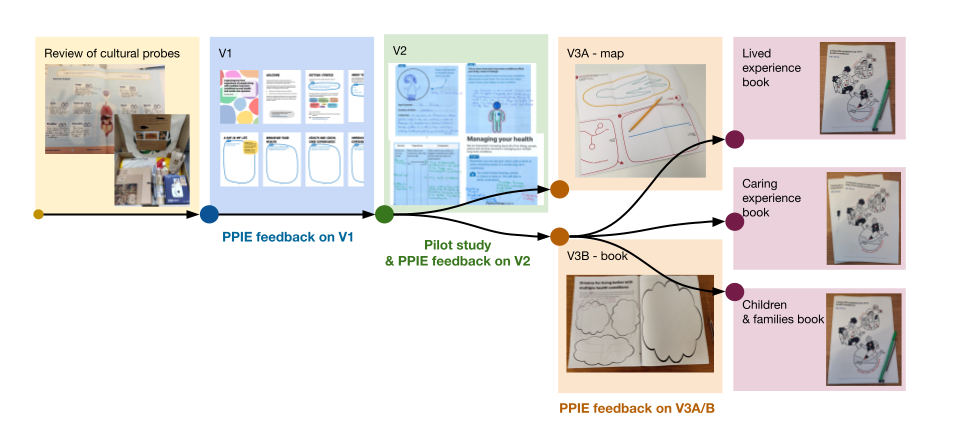MLTC activity books¶
3 activity books developed during Stage 1.
Living with MLTC activity book
Caring for someone with MLTC activity book
Children and families activity book
Overview¶
The activity books were developed as part of a set of flexible research methods designed to explore the experiences of living with multiple long-term conditions (MLTC). The activity books provide participants with an asynchronous, creative, and reflective way to share insights into their daily lives, health, and care experiences. The activity books are intended to allow participants to document their experiences over a period of time, and offer flexibility in how they choose to engage with the materials.
Rooted in the cultural probe methodology,1 a review of existing cultural probes was conducted before the activity books were co-developed with Public Advisors (PAs). Through iterative design and feedback cycles, we created three activity the books, tailored to specific perspectives:
- Living with MLTCs
- Caring for someone with MLTCs
- Children & families (living with or at risk of developing MLTCs)
The books seek to understand the person’s context, daily life, experiences of MLTC, and interactions with health and care systems.
Application & use¶
Design and development process¶
Design and development of the activity books.
The books were designed and developed specifically for the SysteMatic project, in collaboration with our Public Advisors. Their input ensured activities were sensitive, context-appropriate, and person-centered. Activities in the books include: timelines, body mapping, mind mapping.
Design principles¶
Encouraging creativity: The books were physical, featuring diagrams, timelines, and spaces for activities like body mapping and mind mapping, to move beyond static question-answer formats.
Flexibility: Participants could: write and draw in the books, type responses on a computer/smartphone, share photos, videos, or voice notes.
Supported, not stand alone: Conversations with participants were carried out beforehand to ensure clarity and encourage reflective, creative responses. Accompanying instruction videos were also available, talking through the activity books.
Activity books as part of a set of methods¶
It is important to recognise that not every qualitative research method suits every individual. To accommodate diverse needs, we offered a choice of engagement methods, including activity books, workshops, and one-on-one interviews. Participants could choose one method or any combination, with support provided to help them identify the best option for their circumstances. For example, the activity books may not be appropriate for individuals with low literacy levels.
Examples of when the activity books were useful/appropriate:
- Participants with social anxiety which prevented them from wanting to take part in workshops or interviews; in these cases, the activity books offered a more comfortable and private alternative.
- Participants experiencing chronic fatigue appreciated the flexibility of being able to dip in and out of the books when they felt able, making them a less time-intensive option compared to workshops or interviews.
- For participants selecting multiple methods, we sent them the activity books first as a tool for reflection, which helped enrich interviews and workshop discussions.
The activities developed for the books were also adapted for other contexts, such as:
- Using the activity books as interview guides to facilitate structured yet flexible discussions.
- Using the activities in workshops e.g. bodymapping.
The flexibility offered by the set of methods ensured that each participant could engage in a way that aligned with their preferences, abilities, and energy levels, fostering inclusivity and richer data collection.
Results & insights¶
Completed activity books.
The activity books yielded valuable and multifaceted insights into the lives of participants living with MLTCs, providing both rich data for analysis and a meaningful experience for participants. Completing the books over time offered a deeper understanding of lived experiences, capturing evolving feelings and circumstances rather than a snapshot of a single day. Both Public Advisors and participants told us they found the process therapeutic; they valued the opportunity to pause and reflect on their lives, which they found both insightful and empowering. Participants appreciated the ability to work flexibily, and at their own pace, which was particularly valuable for individuals managing fatigue or fluctuating health. Overall, the activity books demonstrate the potential for creative and adaptable tools to uncover the nuanced, lived experiences of people navigating complex health systems. They should be offered as part of a set of flexible methods helping individuals to foster a sense of agency and control over their own participation.
Accompanying instruction videos¶
Living with multiple long-term conditions¶
Caring for someone with multiple long-term conditions¶
References¶
-
Wherton J, et al. Designing assisted living technologies ‘in the wild’: preliminary experiences with cultural probe methodology. BMC medical research methodology 2012;12(1), pp.1-13. ↩


